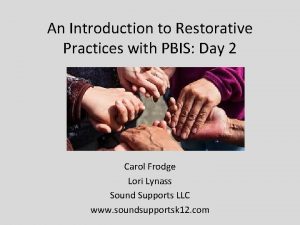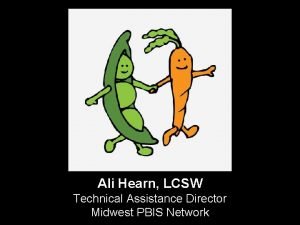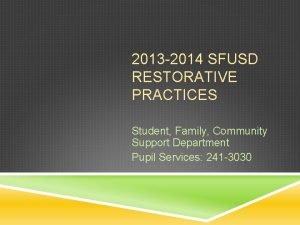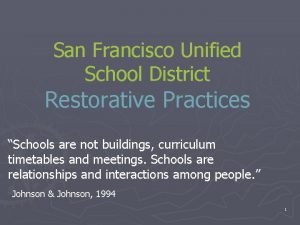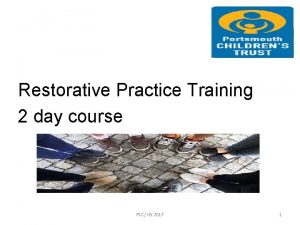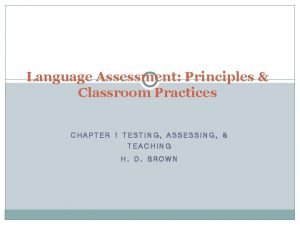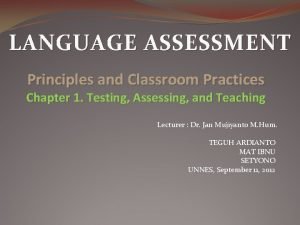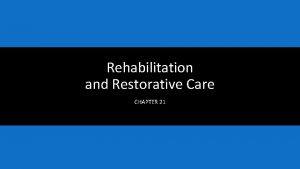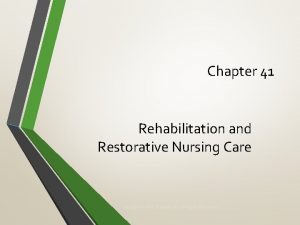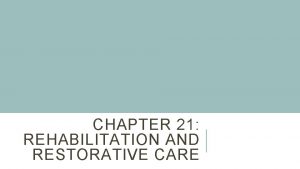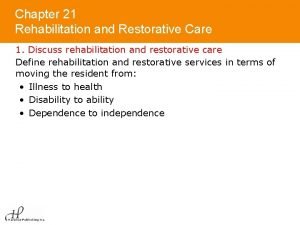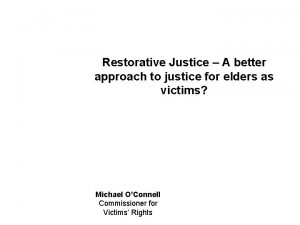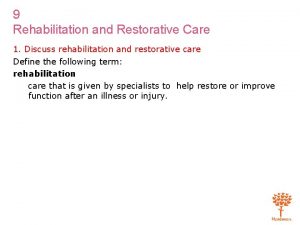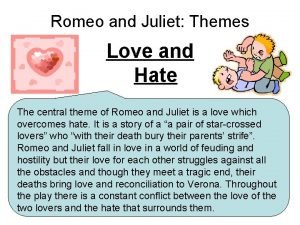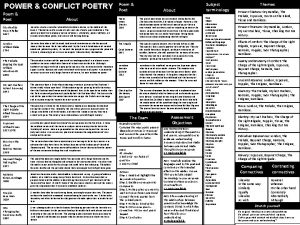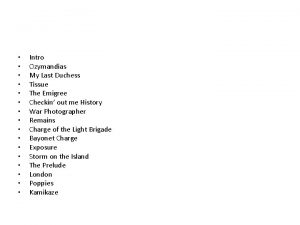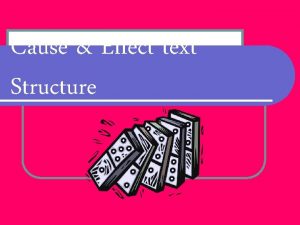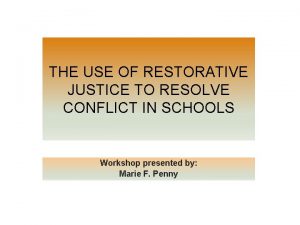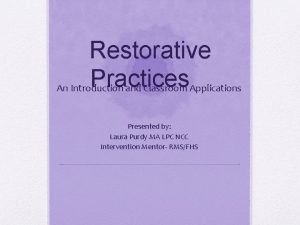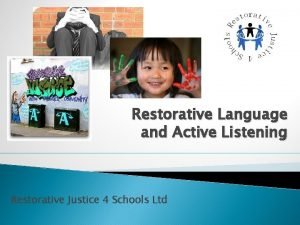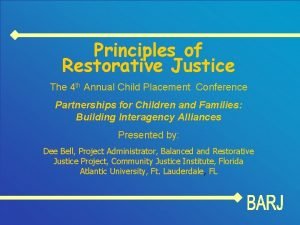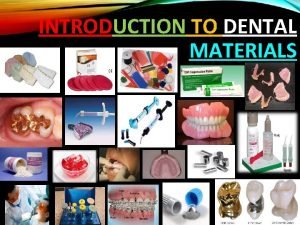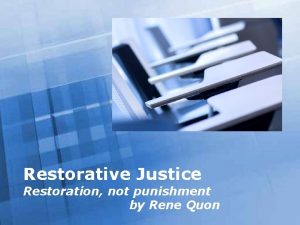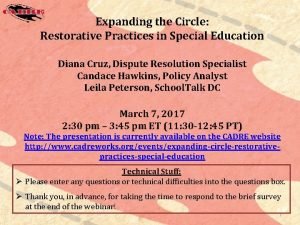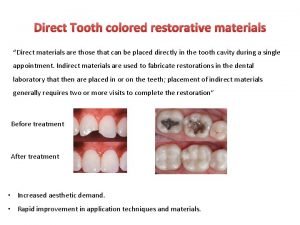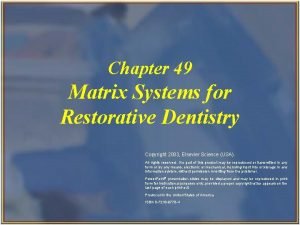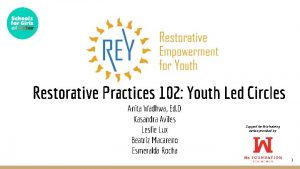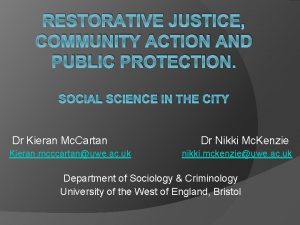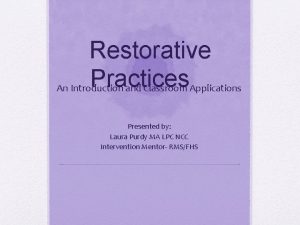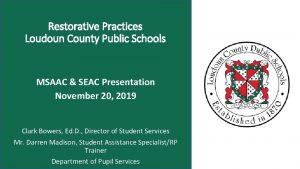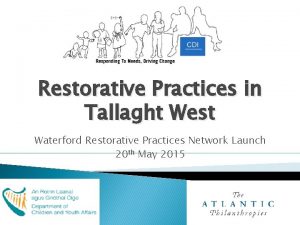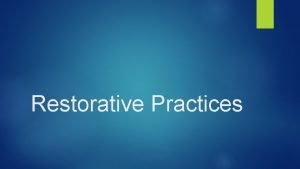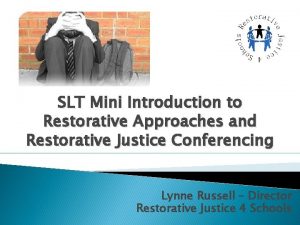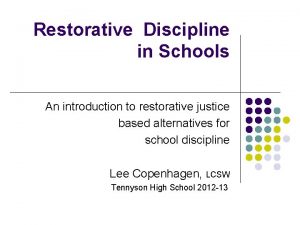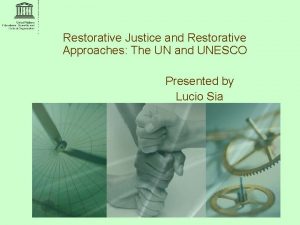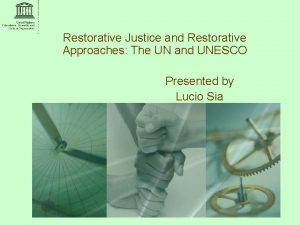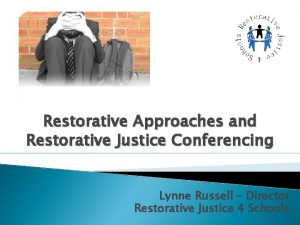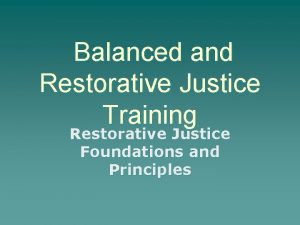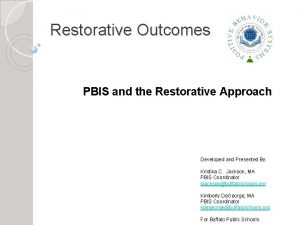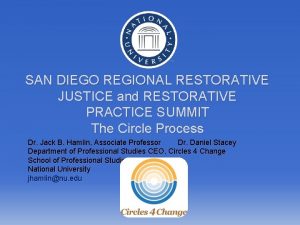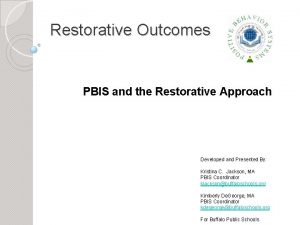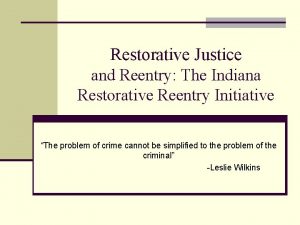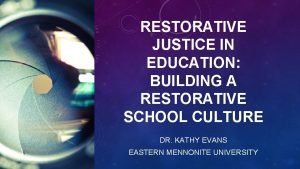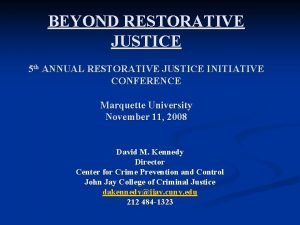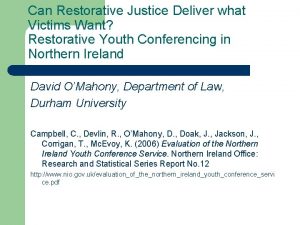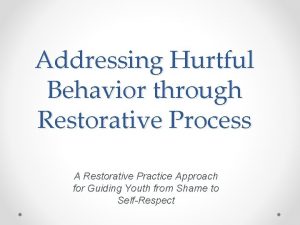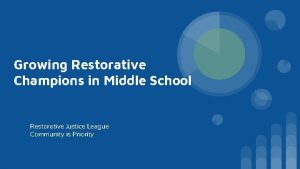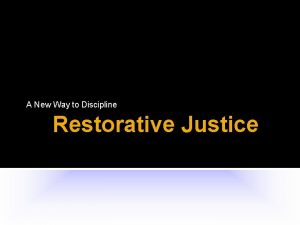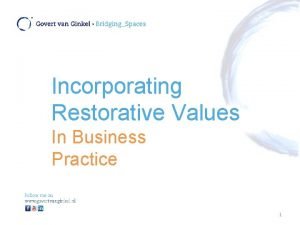Restorative Practices An Introduction and Classroom Applications Presented































- Slides: 31

Restorative Practices An Introduction and Classroom Applications Presented by: Laura Purdy MA LPC NCC Intervention Mentor- RMS/FHS

What is Restorative Practices • Restorative Practices is an emerging social science that studies how to strengthen relationships between individuals as well as social connections in the community. (IIRP. edu)

Where is it used Restorative Practices is being applied in the following settings: • K-12 and Higher Education • Community Health • Organizational Leadership • Criminal Justice • Counseling and Social Work

Restorative Continuum

Social Discipline Window Positive changes occur when people in authority do things with them rather than to or for.

Restorative Questions To the wrongdoer: To the person harmed: • What happened? • What were you thinking at the time? • What did you think when it happened? • What have you thought about since? • Who do you think has been affected by what you did? • How has it affected you? • In what way? • What's been the hardest part for you? • What do you need to do to make things right? • What's needed to make things right? • How can we make sure this doesn't happen again? • What can we do to help you?

Why use RP in schools • Inclusive- all voices are heard • Creates healthy school climate • Teaches accountability • Teaches healthy communication

No More Zero Tolernace • The zero tolerance policies of the 1990’s aimed to make schools safer • What it did was exclude/isolate students from their community, deny them access to an education, harm relationships

Michigan Law New Michigan Law- MCL 380. 1310 c Effective August 1, 2017 The school shall consider using restorative practices in addition or as an alternative to suspension or expulsion. • Schools need to consider use of restorative practices: • Instead of suspensions/expulsions • Along with suspensions/expulsions • Conflicts w/out suspensions/expulsions SO BASICALLY ALL THE TIME!

AND MOST IMPORTANTLY • BECAUSE IT’S GREAT FOR STUDENTS, STAFF, AND THE COMMUNITY! Research has shown Restorative Justice improves the school environment, enhances the learning and development of young people, and promotes safety, inclusion, respect, and positive relationships (Ashley & Burke, 2009, p. 18). Research also shows that schools who implement RJ programs see a lowered reliance on detention and suspension; a decline in disciplinary problems, truancy, and dropout rates; and an improvement in school climate and student attitudes (Graves & Mirsky, 2007).

RP in Your Classroom VIDEO: Using Dialog Circles to Support Classroom Management From Edutopia (4 min) https: //youtu. be/q. Tr 4 v 0 e. Yig. M

RP in Your Classroom- Where to start • Positive Affective Statements • Circles

Affective Statements Description and Purpose: • Are personal expressions of feeling in response to specific positive or negative behaviors of others. • Are central to all of the more formal restorative practices. • Provide feedback on the impact and scope of intended or unintended harm resulting from negative behaviors. • Provide information that can be used to restore a good feeling between people when harm has been done to their relationship. • Humanize the person making them, immediately changing the dynamic between the people involved. This sharing of emotions or “getting real” is what makes it possible to improve relationships in a school community. • Have a significant and cumulative impact in a school community.

Affective Statements Characteristics of High Quality Affective Statements: • Are “I” statements that express a feeling. • Make students aware of either the positive or negative impact of their behavior. • Provide a precise description of a student’s behaviors and the specific impact of those behaviors. • Do NOT protect students from the consequences of their behavior. • Are strategically delivered in a time frame, place and manner most likely to maximize impact. • Are delivered in a personalized manner directly to the student who impacted others. • Focus on behavior, not on the intrinsic worth of the person (separates the deed from the doer). • Are respectful in tone. • Encourage students to express feelings.

Positive Affective Statement I am so proud to see/hear… I am so excited to see/hear… I am so appreciative of you/your… I am so grateful that/for…… I am so thankful that/for…… I am delighted to learn/see/hear … I am so pleased to see/hear/by…… I am so impressed by… I am so touched that you…

Using affective statements with negative behavior

Where can you use this? ? ? Talk with a neighbor about how you can intentionally use this with your students.

Classroom Circle A circle is a versatile restorative practice that can be used proactively, to develop relationships and build community or reactively, to respond to wrongdoing, conflicts and problems. Circles give people an opportunity to speak and listen to one another in an atmosphere of safety, decorum and equality. • Prepare yourself and students ahead of time • Set behavior expectations • Teach how to “circle up” • Discuss how to use a talking piece • When beginning, keep it light and fun!


Circle Rules Sample • Please listen and speak with respect: language—both verbal and nonverbal—can be quite powerful. • Respect everyone’s privacy—only tell your own story. • Share time fairly. • Please speak only when you have the talking piece. • As the facilitator, I may need to speak to move things along. • You may pass, but help us remember to come back to you.

Circle Process • “Circle Up” – prepare your classroom with students help • Review expectations, if needed • Introduction/Opening • Check in/Share (Keep it positive!) • Discussion/Activity • Summary/Check out

LET’S GIVE IT A TRY!!! Let’s “cirlcle up”!

Classroom Circles Ideas • Check in/Check out (sentence starters, one word answers) • Games (ie. The wind blows when…) • Teaching (content questions, reading, lecture, turn and talk) • Dialog Circles • Problem-solving (whole class rules, reoccurring concerns) • Hellos and Goodbyes for students

Classroom Circle Tips • Guide the process with confidence! • Students will follow your lead. Be genuine and open. • Do the things you’ve always done, but through a restorative lens. • Use the RP language, ideas, and processes. • Create a classroom ritual/tradition! • Students love predictability, consistency, safety.

One step further… • When your comfortable using the proactive approaches, move deeper to help manage problems, encourage accountability, and create more meaningful relationships by helping students make right what was wrong. • Getting Started Using Restorative Inquiry https: //www. tolerance. org/sites/default/files/2017 -08/teachingtolerance-get-started-using-restorative-inquiry. pdf • Questions for : • Social Restoration • Self- Restoration

RP and MTSS

Replacing Punishment with Restorative Approaches https: //www. youtube. com/watch? v=g 8_94 O 4 Ex. SA 7 min 30 sec


Resources • International Institute for Restorative Practices • Iirp. edu

Want to learn more? ? ? Please feel free to contact me: Laura Purdy: 586 -439 -7542 • Consultation or In-class Support • Facilitate circles • Restorative conferences • Additional resources

 Pbis and restorative practices
Pbis and restorative practices Ali hearn
Ali hearn Sfusd restorative practices
Sfusd restorative practices San francisco unified school district restorative practices
San francisco unified school district restorative practices Social discipline window
Social discipline window Language assessment principles and classroom practices
Language assessment principles and classroom practices Language assessment: principles and classroom practices
Language assessment: principles and classroom practices Btech smart classes
Btech smart classes Rehabilitation and restorative care chapter 21
Rehabilitation and restorative care chapter 21 Chapter 41 rehabilitation and restorative nursing care
Chapter 41 rehabilitation and restorative nursing care Chapter 21 rehabilitation and restorative care
Chapter 21 rehabilitation and restorative care Chapter 21 rehabilitation and restorative care
Chapter 21 rehabilitation and restorative care Pros and cons of restorative justice
Pros and cons of restorative justice Rehabilitation and restorative care test
Rehabilitation and restorative care test Jekyll and hyde setting
Jekyll and hyde setting Romeo and juliet themes
Romeo and juliet themes Juxtaposition in ozymandias
Juxtaposition in ozymandias Ozymandias imagery
Ozymandias imagery Cause and effect structure words
Cause and effect structure words Restorative circle questions
Restorative circle questions Circle norms
Circle norms Restorative language
Restorative language Principles behind restorative justice
Principles behind restorative justice Auxiliary dental materials examples
Auxiliary dental materials examples Restorative frahm carver
Restorative frahm carver Restorative justice in schools powerpoint
Restorative justice in schools powerpoint Restorative practice circle questions
Restorative practice circle questions Tooth colored restorative materials
Tooth colored restorative materials T shaped matrix band
T shaped matrix band Restorative conversation script
Restorative conversation script Restorative circle script
Restorative circle script Social justice and community action
Social justice and community action
